In a recent opinion piece in Art+Auction titled Why Art Galleries Matter, Dorsey Waxter called on collectors and investors, flaneurs and aesthetes to forego biennials and art fairs and spend more time at local galleries as they are the engines that drive the whole art enterprise. It’s good sense.
With No-Mad-Ness in No Man’s Land, currently on view at Eslite Gallery (誠品畫廊), US-based curators Leeza Ahmady and Ombretta Agro Andurff have assembled an exceptionally clear-sighted group show notable for its thematic coherence and concise execution. Five years in the making from idea to execution, it counts as one of the best shows in Taipei this year.
The curatorial idea is nomadism, with all its broad contemporary connotations of movement, madness and marginalization, and cognate notions of migration, diaspora and borders. Ahmady and Andurff possess a delicate touch and approach the topic with detachment, intelligence and humor. Even when touching on potentially explosive issues, the show wears its politics lightly. And yet the exhibition — which includes 10 artists from eight countries, including Palestine, the Philippines, Uzbekistan, Lebanon, Afghanistan, India, Kazakhstan and Israel-Palestine — remains as much a cultural investigation of these under-represented countries as it is an aesthetic experience.
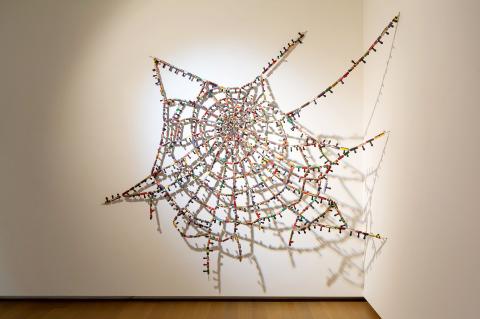
Photo courtesy of Eslite Gallery
Andruff told the Taipei Times that the chosen artists, many of whom have represented their countries at the Venice Biennale and Documenta, are “deeply rooted in their own culture but use recognized iconography that everyone can understand.” The employment of local imagery to speak in a global voice is the key to unlocking the entire show.
This is most clearly manifested in Yelena and Viktor Vorobyev’s Knife, a park bench-sized sculpture in the shape of a kitchen knife made from wood and stone. Seen on the gallery floor, it appears a throwaway emblem, large and inert. Its deceptive simplicity, however, is pregnant with associations: the hunt and the hearth, the secure and the violent, the domestic and the predatory, the masculine and the feminine. It is such a well-crafted tactile object that one is tempted to touch it, run a finger along its jagged blade. A tool of power, yet of domestication and, in our day — with its Michelin stars and plastic surgery — rarefied skill, the object evokes a tangent along which we can imagine the development of society from hunter-gatherer to the sedentary lifestyle found in today’s advanced countries.
Reena Saini Kallat works in a similar kind of duality, but here moves beyond nomadism into the realm of border crossings. In Untitled (Cobweb Knots and Crossings), Kallat, from India, affixes together hundreds of rubber stamps emblazoned with national flags to form the shape of a web. The object can be a trap, the individual entangled in bureaucratic network of officialdom, or a home.
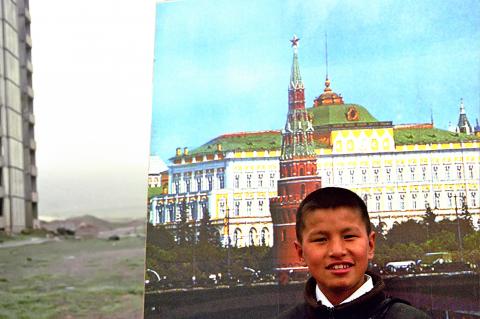
Photo courtesy of Eslite Gallery
Borders and migration are themes picked up by Isabel and Alfredo Aquilizan, an Australia-based Filipino husband and wife. Their Address is a monumental installation in the shape and size of a roofless shack, assembled from 140 boxes that contain all manner of household objects — clothing, toys, board games, fans and computers — that the artists have accumulated over the years. It serves as a powerful symbol of the Filipino diaspora, the objects are memories a family gathers over a lifetime of movement.
There is much else to see here and though the theme might be broad, it is never derivative. Sharif Waked’s video of a donkey forced to undergo a shower to remove its zebra stripes in Bath Time, is an amusing statement about identities immigrants undergo and have to strip in a new land.
One gains the sense over the past few years that Taipei’s galleries are cluing in to the importance of reaching out to international artists and curators. Hopefully, exchanges will result from this. And what is remarkable here is that they are doing so while moderating the rarefied language that has become de rigeur of public museums. No-Mad-Ness in No Man’s Land is a fine example of how a commercial gallery can successfully work with international curators and artists. Let’s hope to see more of this in the future.
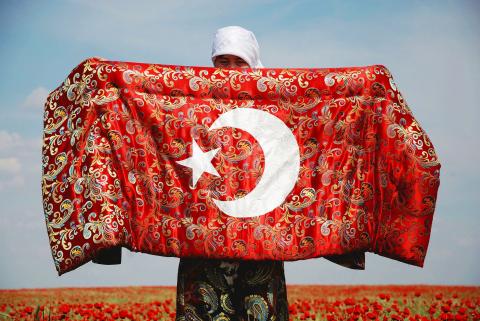
Photo courtesy of Eslite Gallery
■ No-Mad-Ness in No Man’s Land runs until Dec. 22 at Eslite Gallery (誠品畫廊), 5F, 11 Songgao Rd, Taipei City (台北市松高路11號5樓), tel: (02) 8789-3388 X1588. Open Tuesdays to Sundays from 11am to 7pm.
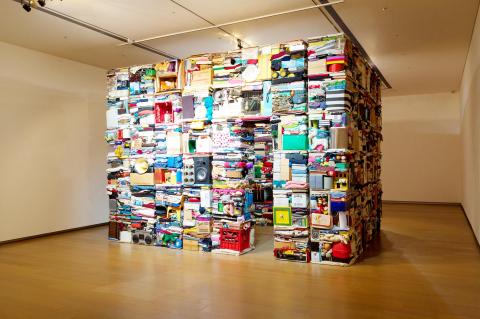
Photo courtesy of Eslite Gallery
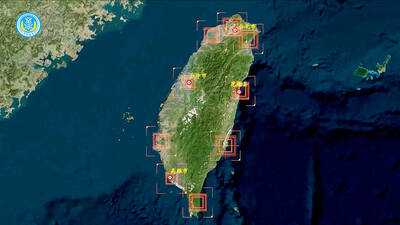
The People’s Republic of China (PRC) last week offered us a glimpse of the violence it plans against Taiwan, with two days of blockade drills conducted around the nation and live-fire exercises not far away in the East China Sea. The PRC said it had practiced hitting “simulated targets of key ports and energy facilities.” Taiwan confirmed on Thursday that PRC Coast Guard ships were directed by the its Eastern Theater Command, meaning that they are assumed to be military assets in a confrontation. Because of this, the number of assets available to the PRC navy is far, far bigger

The 1990s were a turbulent time for the Chinese Nationalist Party’s (KMT) patronage factions. For a look at how they formed, check out the March 2 “Deep Dives.” In the boom years of the 1980s and 1990s the factions amassed fortunes from corruption, access to the levers of local government and prime access to property. They also moved into industries like construction and the gravel business, devastating river ecosystems while the governments they controlled looked the other way. By this period, the factions had largely carved out geographical feifdoms in the local jurisdictions the national KMT restrained them to. For example,

The remains of this Japanese-era trail designed to protect the camphor industry make for a scenic day-hike, a fascinating overnight hike or a challenging multi-day adventure Maolin District (茂林) in Kaohsiung is well known for beautiful roadside scenery, waterfalls, the annual butterfly migration and indigenous culture. A lesser known but worthwhile destination here lies along the very top of the valley: the Liugui Security Path (六龜警備道). This relic of the Japanese era once isolated the Maolin valley from the outside world but now serves to draw tourists in. The path originally ran for about 50km, but not all of this trail is still easily walkable. The nicest section for a simple day hike is the heavily trafficked southern section above Maolin and Wanshan (萬山) villages. Remains of

Shunxian Temple (順賢宮) is luxurious. Massive, exquisitely ornamented, in pristine condition and yet varnished by the passing of time. General manager Huang Wen-jeng (黃文正) points to a ceiling in a little anteroom: a splendid painting of a tiger stares at us from above. Wherever you walk, his eyes seem riveted on you. “When you pray or when you tribute money, he is still there, looking at you,” he says. But the tiger isn’t threatening — indeed, it’s there to protect locals. Not that they may need it because Neimen District (內門) in Kaohsiung has a martial tradition dating back centuries. On